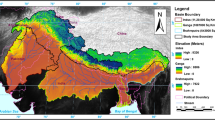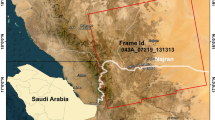Abstract
The high groundwater level coal mining areas have a long history of mining and are mainly located in east-central region of China. Subsidence caused by coal mining occur in several different periods. However, the subsidence change regularity in each periods remains unclear. This study aimed to reveal the subsidence change regularity in high groundwater level coal mining areas during different periods. The Juye coal mine, located in Heze City, Shandong Province, China, was selected for the study. Firstly, 55 Sentinel-1A radar satellite images from August 2018 to July 2020 were acquired for this research. The “two-track method” of D-InSAR technology was employed to process the images. Secondly, based on subsidence velocity of 1.7 mm/day, the subsidence process was divided into three periods: initial, active and weakening. Thirdly, elevation data of ground levelling points were used to check the accuracy of subsidence monitoring using Sentinel-1A data. At last, the subsidence change process in different periods was analyzed and the change regularity was summarized. The results are shown as follows: (1) the monitoring accuracy of different periods is high, and R2range from 0.961 to 0.983. (2) The subsidence characteristics are not obvious in initial period. The subsidence funnel begin to form and the mean maximum subsidence in center is greater than 1400 mm in active period. The subsidence velocity gradually decrease and eventually stabilize in weakening period. (3) Appearance of subsidence, development of subsidence funnels and formation of subsidence basins are spatial period characteristics of coal mining-induced subsidence. The results can provide an important basis for land conservation in mining areas.






Similar content being viewed by others
Data availability
Data will be made available on request.
References
Alexakis DD, Mexis FK, Vozinaki AK, Daliakopoulos IN, Tsanis IK (2017) Soil moisture content estimation based on sentinel-1 and auxiliary earth observation products. A Hydrological Approach. Sensors 17:1455. https://doi.org/10.3390/s17061455
Chen CX, Su J, Zhao ZY (2017) Study of surface movement principle of coal seam mining under super thick unconsolidated stratum. Coal Min Technol 22(3):76–78. https://doi.org/10.13532/j.cnki.cn11-3677/td.2017.03.001
Cui XM, Zhao YL, Wang GR, Zhang B, Li CY (2020) Calculation of residual surface subsidence above abandoned longwall coal mining. Sustainability 12(4):1528. https://doi.org/10.3390/su12041528
Dong LK, Wang C, Tang YX, Tang FQ, Zhang H, Wang J, Duan W (2021) Time series InSAR three-dimensional displacement inversion model of coal mining areas based on symmetrical features of mining subsidence. Remote Sens 13(11):2143. https://doi.org/10.3390/rs13112143
Edalat A, Khodaparast M, Rajabi AM (2020) Detecting land subsidence due to groundwater withdrawal in Aliabad Plain, Iran, using ESA Sentinel-1 satellite data. Nat Resour Res 29:1935–1950. https://doi.org/10.1007/s11053-019-09546-w
Fu YP, Li CT, Pang JW, Ji XF (2022) Advancing speed efficiency of roof failure law in large mining height working face. Coal Technol 41(2):14–17. https://doi.org/10.13301/j.cnki.ct.2022.02.004
Garcia GA, Venturini V, Brogioni M, Walker E, Rodriguez L (2019) Soil moisture estimation over flat lands in the Argentinian Pampas region using Sentinel-1A data and non-parametric methods. Int J Remote Sens 40:10. https://doi.org/10.1080/01431161.2018.1552813
Guzy A, Witkowski WT (2021) Land subsidence estimation for aquifer drainage induced by underground mining. Energies 14(15):4658. https://doi.org/10.3390/en14154658
Haas J, Ban YF (2017) Sentinel-1A SAR and sentinel-2A MSI data fusion for urban ecosystem service map**. Remote Sens Appl Soc Environ 8:41–53. https://doi.org/10.1016/j.rsase.2017.07.006
He TT, **ao W, Zhao YL, Deng XY, Hu ZQ (2020) Identification of waterlogging in Eastern China induced by mining subsidence: a case study of Google Earth Engine time-series analysis applied to the Huainan coal field. Remote Sens Environ 242:111742. https://doi.org/10.1016/j.rse.2020.111742
Hou DF, Xu SJ, Qi LL (2021) Study on the law of dynamic surface movement and prediction of mining under thick alluvium. J Min Sci Technol 6(1):60–70. https://doi.org/10.19606/j.cnki.jmst.2021.01.007
Hu X, Li XJ, Min XY, Niu BB (2020) Optimal scale extraction of farmland in coal mining areas with high groundwater levels based on visible light images from an unmanned aerial vehicle (UAV). Earth Sci Inf 13:1151–1162. https://doi.org/10.1007/s12145-020-00493-2
Hu X, Niu BB, Li XJ, Min XY (2021) Unmanned aerial vehicle (UAV) remote sensing estimation of wheat chlorophyll in subsidence area of coal mine with high phreatic level. Earth Sci Inf 14:2171–2181. https://doi.org/10.1007/s12145-021-00676-5
Kussul N, Lemoine G, Gallego FJ, Skakun SV, Lavreniuk M, Shelestov AY (2016) Parcel-based crop classification in Ukraine using Landsat-8 data and Sentinel-1A data. IEEE J Sel Top Appl Earth Observ Remote Sens 9(6):2500–2508. https://doi.org/10.1109/JSTARS.2016.2560141
Laurin GV, Balling J, Corona P, Mattioli W, Dario P, Puletti N, Rizzo M, Truckenbrodt J, Urban M (2018) Above-ground biomass prediction by Sentinel-1 multitemporal data in central Italy with integration of ALOS2 and Sentinel-2 data. J Appl Remote Sens 12(1):016008. https://doi.org/10.1117/1.JRS.12.016008
Li XJ, Zhou JJ (2020) Research on surface subsidence information extraction method based on high phreatic coal mining area. Coal Sci Technol 48(4):105–112. https://doi.org/10.13199/j.cnki.cst.2020.04.010
Li JC, Gao F, Lu JG (2019a) An application of InSAR time-series analysis for the assessment of mining-induced structural damage in Panji Mine, China. Nat Hazards 97:243–258. https://doi.org/10.1007/s11069-019-03639-8
Li JC, Gao F, Lu JG, Tao TY (2019b) Deformation monitoring and prediction for residential areas in the Panji mining area based on an InSAR time series analysis and the GM-SVR model. Open Geosci 11(1):738–749. https://doi.org/10.1515/geo-2019-0058
Lohberger S, Stngel M, Atwood EC, Siegert F (2017) Spatial evaluation of Indonesia’s 2015 fire-affected area and estimated carbon emissions using Sentinel-1. Glob Change Biol 24(2):644–654. https://doi.org/10.1111/gcb.13841
Min XY, Xu DY, Hu X, Li XJ (2022) Changes in total organic carbon and organic carbon fractions of reclaimed minesoils in response to the filling of different substrates. J Environ Manag 312:114928. https://doi.org/10.1016/j.jenvman.2022.114928
Ng AH, Ge LL, Du ZY, Wang SR, Ma C (2017) Satellite radar interferometry for monitoring subsidence induced by longwall mining activity using Radarsat-2, Sentinel-1 and ALOS-2 data. Int J Appl Earth Observ Geoinf 61:92–103. https://doi.org/10.1016/j.jag.2017.05.009
Pandey AC, Kaushik K, Parida BR (2022) Google Earth Engine for large-scale flood map** using SAR data and impact assessment on agriculture and population of Ganga-Brahmaputra basin. Sustainability 14(7):4210. https://doi.org/10.3390/su14074210
Petroni M, Howard S, Howell IB, Collins MB (2021) NYenviroScreen: An open-source data driven method for identifying potential environmental justice communities in New York State. Environ Sci Policy 124:348–358. https://doi.org/10.1016/j.envsci.2021.07.004
Pillot B, Muselli M, Poggi P, Haurant P, Dias JB (2016) Development and validation of a new efficient SRTM DEM-based horizon model combined with optimization and error prediction methods. Sol Energy 129:101–115. https://doi.org/10.1016/j.solener.2016.01.058
Przyłucka M, Kowalski Z, Perski Z (2022) Twenty years of coal mining-induced subsidence in the Upper Silesia in Poland identified using InSAR. Int J Coal Sci Technol 9:86. https://doi.org/10.1007/s40789-022-00541-w
Reiche J, Hamunyela E, Verbesselt J, Hoekman D, Herold M (2018) Improving near-real time deforestation monitoring in tropical dry forests by combining dense Sentinel-1 time series with Landsat and ALOS-2 PALSAR-2. Remote Sens Environ 204:147–161. https://doi.org/10.1016/j.rse.2017.10.034
Schlögl M, Widhalm B, Avian M (2021) Comprehensive time-series analysis of bridge deformation using differential satellite radar interferometry based on Sentinel-1. ISPRS J Photogramm Remote Sens 172:132–146. https://doi.org/10.1016/j.isprsjprs.2020.12.001
Strzałkowski P (2021) Duration of the final phase of mining area deformation process in the conditions of Upper Silesia (Poland). Bull Eng Geol Environ 80:5769–5780. https://doi.org/10.1007/s10064-021-02272-9
Wang ZH, Ren JT, Fan CC, Liu JB, Lei Y, Feng T (2021) Applicability analysis of sentinel-1A in surface subsidence monitoring in southwest coal mining area. Prog Geophys 36(6):2339–2350. https://doi.org/10.6038/pg2021EE0577
Wempen JM (2020) Application of D-InSAR for short period monitoring of initial subsidence due to longwall mining in the mountain west United States. Int J Min Sci Technol 30:33–37. https://doi.org/10.1016/j.ijmst.2019.12.011
**ao W, Fu YH, Wang T, Lv XJ (2018) Effects of land use transitions due to underground coal mining on ecosystem services in high groundwater table areas: a case study in the Yanzhou coalfield. Land Use Policy 71:213–221. https://doi.org/10.1016/j.landusepol.2017.11.059
Xu ZX, Ji M, Zhang G, Chen ZW (2022) Method for dynamic prediction of mining subsidence based on the SBAS-InSAR technology and the logistic model. Remote Sens Nat Resour 34(2):20–29. https://doi.org/10.6046/zrzyyg.2021354
Zhang SW, Bu ZY, Shen Q, Yang SW, Hu QQ, Zhou Y, Luo M (2017) Resistance and priority analysis of landscape forest fields, lakes, and grass restoration in Dabaoshan mining basin. Acta Ecol Sin 29(23):8920–8929. https://doi.org/10.5846/stxb201905291121
Zhang YH, Wu HG, Li MJ, Kang YH, Lu Z (2021) Investigating ground subsidence and the causes over the whole jiangsu province, China using Sentinel-1 SAR data. Remote Sens 13(2):179. https://doi.org/10.3390/rs13020179
Zhou H, Dai KR, Pirasteh S, Li RP, **ang JM, Li ZH (2023) InSAR spatial-heterogeneity tropospheric delay correction in steep mountainous areas based on deep learning for landslides monitoring. IEEE Trans Geosci Remote Sens 61:5215014. https://doi.org/10.1109/TGRS.2023.3307477
Funding
This paper was supported by the National Natural Science Foundation of China (No. 42077446) and The National Key R&D Program of China (No. 2022YFE0127700).
Author information
Authors and Affiliations
Corresponding authors
Ethics declarations
Conflict of interest
The authors declare no competing interests.
Consent for publication
The manuscript is approved by all authors for publication.
Ethics approval and consent to participate
The research does not involve human participants and animals.
Additional information
Publisher's Note
Springer Nature remains neutral with regard to jurisdictional claims in published maps and institutional affiliations.
Rights and permissions
Springer Nature or its licensor (e.g. a society or other partner) holds exclusive rights to this article under a publishing agreement with the author(s) or other rightsholder(s); author self-archiving of the accepted manuscript version of this article is solely governed by the terms of such publishing agreement and applicable law.
About this article
Cite this article
Jiang, X., Li, X., Li, J. et al. Examining subsidence change regularity in high groundwater level coal mining areas using Sentinel-1A time-series data. Nat Hazards (2024). https://doi.org/10.1007/s11069-024-06646-6
Received:
Accepted:
Published:
DOI: https://doi.org/10.1007/s11069-024-06646-6




